Scotiabank prime rate
Scotiabank’s prime rate was lowered to 4.95% on March 13, 2025.
Scotiabank’s prime rate is the basis for its variable-rate lending products, like credit cards, mortgages and lines of credit. When the Bank of Canada adjusts its overnight rate, Scotiabank’s prime rate increases or decreases by the same amount, affecting the cost of borrowing for these products.
Mortgage rates at Scotiabank’s competitors
Click on a bank’s name to see a full range of its current fixed and variable mortgage rates, including any discounted rates it might be offering.
Scotiabank at a glance
With a history that stretches back to 1832, the Bank of Nova Scotia (Scotiabank) is one of Canada’s oldest and most recognizable financial institutions. From its humble beginnings in Halifax, Scotiabank has grown into an international banking entity with locations across the Americas, the U.K. and Asia.
Scotiabank is the fourth largest of Canada’s Big Six banks and a major player in the country’s mortgage market. In the second quarter of 2023, Scotiabank’s Canadian mortgage portfolio was $300 billion.
Scotiabank mortgage products
In addition to providing traditional mortgage products such as fixed- and variable-rate loans that can be structured as open or closed, Scotiabank also offers:
- Home equity lines of credit.
- Mortgages for second homes and investment properties.
- Mortgage refinances.
- Mortgage renewals.
- Mortgage programs for newly arrived permanent and temporary residents.
Scotiabank mortgages: things to consider
Posted rates vs. special rates
Large lenders often provide two sets of current mortgage rates: posted rates and special, or discounted, rates. Scotiabank, however, is a little different.
Scotiabank posted mortgage rates
Scotiabank’s posted rates are the pre-discounted mortgage rates the bank makes publicly available. Posted rates can be much higher than discounted rates, with the expectation that borrowers will negotiate them down.
There are various theories around why this is the case at major lenders like Scotiabank. Some lending experts believe it’s to make borrowers feel a sense of satisfaction at getting a better deal. Others wonder if a higher posted rate allows banks to charge stiffer penalties if a person breaks their mortgage contract.
If you’re offered a posted rate at Scotiabank, consider it the beginning of a negotiation. It’s also a great reason to compare offers from other lenders.
Scotiabank special rates
Special rates are a lender’s posted rates that have already been discounted, including limited time offers. A special rate will be more in line with the rate you’re actually offered in most circumstances.
Scotiabank is unique among the Big Six in that it doesn’t share its special rates publicly. That doesn’t mean their posted rates are your only option. Scotiabank has an extensive network of mortgage broker partners that get access to discounted mortgage rates.
If you’re offered a posted rate when applying for a mortgage directly with Scotiabank, ask the advisor what rate you’d be offered if you worked with a mortgage broker. If you’re not able to negotiate a discounted rate that’s in line with the bank’s broker offerings, it might be best to use a broker.
Fixed vs. variable mortgage rates
When you get a mortgage from a lender like Scotiabank, you’ll have to make an important choice between a fixed or variable mortgage rate.
Fixed mortgage rates
With a fixed-rate mortgage, your interest rate will remain the same for the duration of your mortgage term. If Scotiabank offers you a 5.25% five-year fixed mortgage rate in 2023, for example, your rate won’t change until it’s time to renew your mortgage in 2028.
A fixed mortgage interest rate allows you to budget around a predictable monthly mortgage payment for years at a time. But if fixed rates fall during your mortgage term, the only way to take advantage is by breaking your mortgage contract and refinancing at a lower rate. Doing so can trigger steep mortgage prepayment penalties.
Variable mortgage rates
If you opt for a variable rate on your Scotiabank mortgage, it could rise or fall many times during your term. When it rises, more of your monthly mortgage payment will go toward interest; when it falls, more will go toward the principal.
Variable mortgage rates have generally been lower than fixed rates. But when variable rates are driven upward by increases to lenders’ prime rates, it can put unexpected pressure on your finances.
From March 2022 to July 2023, for example, homeowners with variable-rate mortgages saw their rates increase 475 basis points. Since one basis point is equal to 0.01%, that means a borrower who secured a variable rate of 2.25% in January of 2022 would be paying 7% in July 2023. That’s not a common occurrence, but it highlights the risk of taking out a variable-rate mortgage during times of economic uncertainty.
Open vs. closed mortgages
Another consideration when getting a mortgage at Scotiabank is whether to choose an open or closed mortgage.
With an open mortgage, you can increase your mortgage payments or even pay your mortgage in full at any time without penalty. A closed mortgage will impose annual limits on how much you can prepay your mortgage.
Choosing between open and closed mortgages is often a matter of cost. Open mortgages tend to come with much higher interest rates.
Convertible mortgages
If you’re unsure how long you’d like a mortgage contract to last, you can also consider a convertible mortgage. Scotiabank offers a six-month, closed convertible mortgage that can be extended to a longer term at any time without incurring a prepayment penalty.
A convertible mortgage can be a helpful option if you expect mortgage rates to fall in the near future. If rates decline to a level you’re satisfied with, you can lock in for several years and pay less in interest.
Rate vs. APR
When investigating Scotiabank’s mortgage rates or comparing them to rates from other lenders, it’s best to use the annual percentage rate (APR) provided rather than the interest rate itself.
APR includes any other fees that might be added to the cost of your mortgage. Factoring in APR gives you a more accurate estimate of your potential mortgage costs.
How to get the best mortgage rate at Scotiabank
As one of Canada’s federally regulated A lenders, Scotiabank follows the country’s strict lending guidelines. That means being offered the best mortgage rates might require a little effort on your part, including:
- Raising your credit score. A high credit score tells lenders that you pay your debts on time. A low credit score, on the other hand, might mark you as more of a credit risk and result in you being offered a higher interest rate. You may not be approved for a mortgage at Scotiabank at all If your credit score is too low. Instead, you might have to apply with one of Canada’s many B lenders.
- Making a larger down payment. If you can make a significant down payment, one that goes well beyond Canada’s minimum down payment guidelines, lenders might see that you prioritize home ownership — but they’ll definitely see that they can loan you less money. Both interpretations mean less risk for the lender, which could mean a lower mortgage rate for you.
- Lowering your debt service ratios. If your debt service ratios are high, it signals to lenders that too much of your income is already going toward paying down debt. That’s risky for lenders, and the more risk you present as a borrower, the higher the rate you’ll be offered.
- Shopping around. Scotiabank may not offer you the best mortgage rate. Looking the rates other lenders are charging is one way to find out whose offer is the right fit for your financial situation.
- Negotiating: Don’t be afraid to ask a Scotiabank home financing advisor. if they can improve on the rate they’ve offered you. If they stand firm, let them know that you’re going to see what other lenders are offering before making a final decision.
How to apply for a mortgage with Scotiabank
With its eHOME mortgage portal, Scotiabank offers fully online mortgage pre-approval and mortgage application processes — something the other Big Six banks have yet to roll out.
Here’s how eHOME works, and what to expect when applying for a mortgage with Scotiabank.
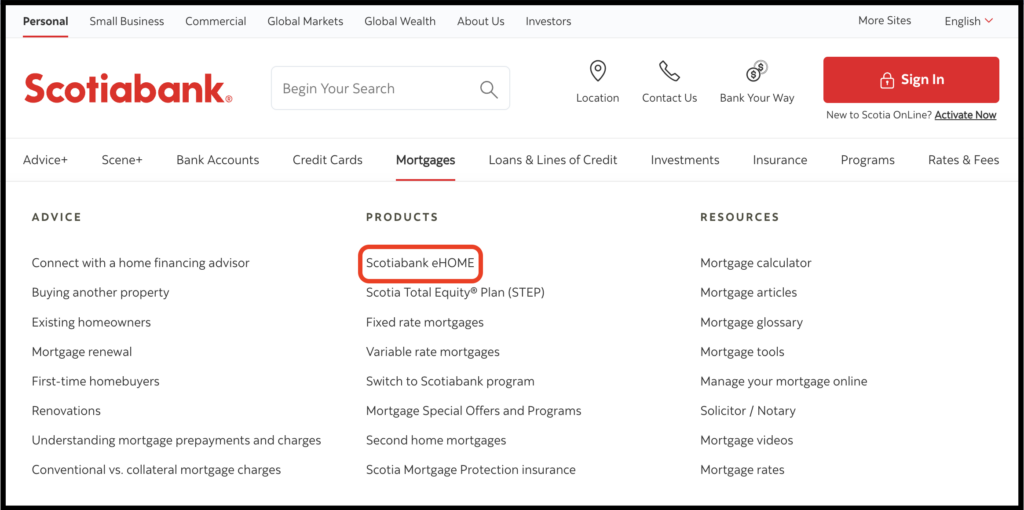
- Go to Scotiabank’s homepage and hover your mouse over the “Mortgages” tab.
- Click on “Scotiabank eHOME” to be taken to the bank’s online mortgage portal.
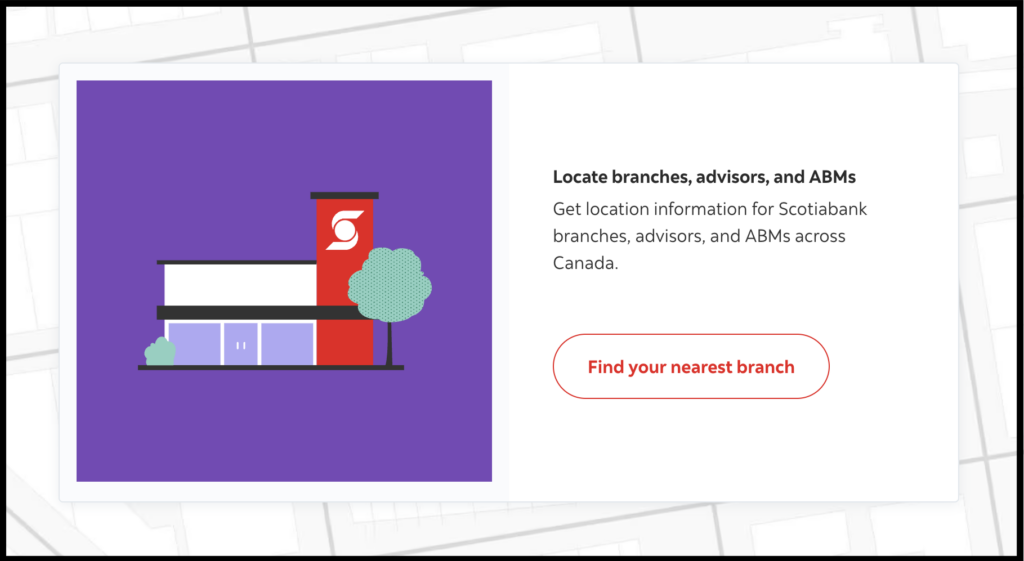
eHOME is an entirely online process, so if you would feel more comfortable dealing with a Scotiabank mortgage advisor instead, you can simply scroll down the bank’s homepage until you see this graphic. You should be able to find a mortgage broker near you who can help you with your mortgage.
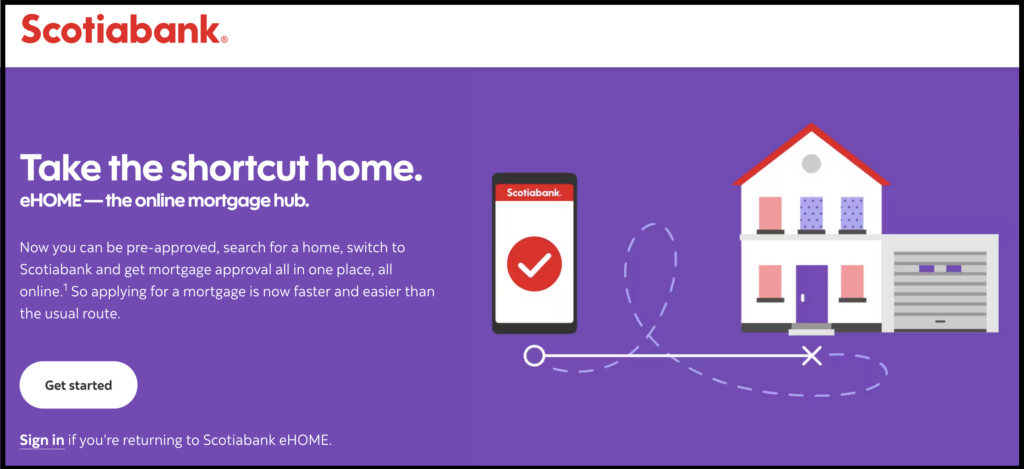
You can scroll around the eHOME page to find more information about how it works, but most of the links will take you to the same place: a set of questions that determine whether you’re eligible to apply for a mortgage online with Scotiabank.
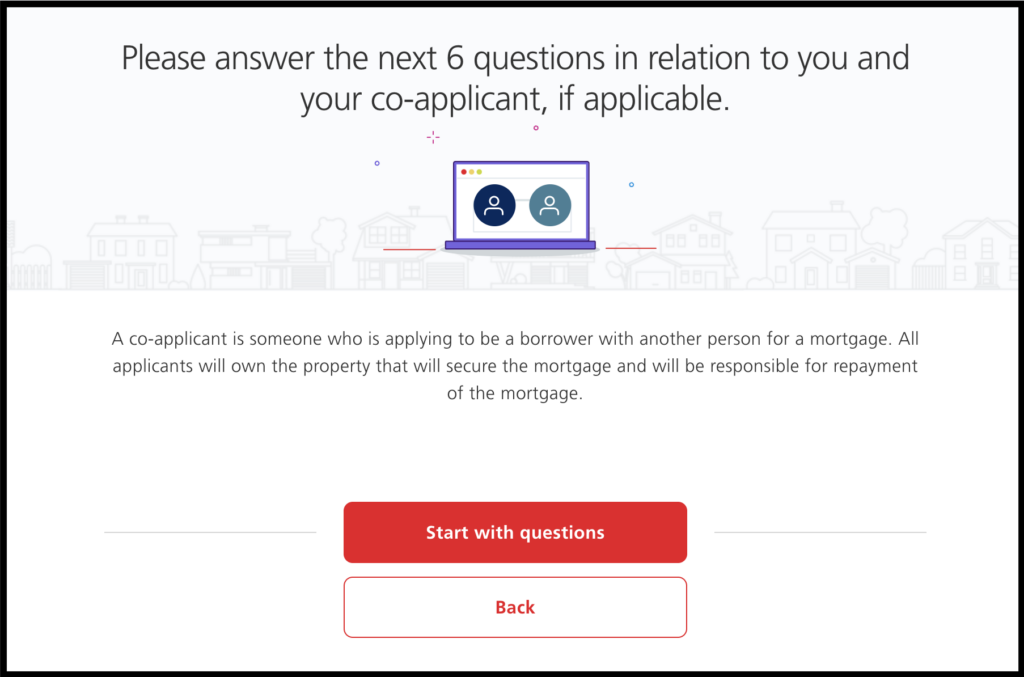
After agreeing to Scotiabank’s privacy agreement, you’ll be asked six yes-or-no questions related to you and your co-borrower, if you have one.
Once you’ve been deemed eligible for eHOME, you can sign in using your Scotiabank credentials.
If you’re not a Scotiabank customer, you’ll have to provide some personal information and a cellphone number so you can initiate your eHOME account. You’ll then create a username and password.
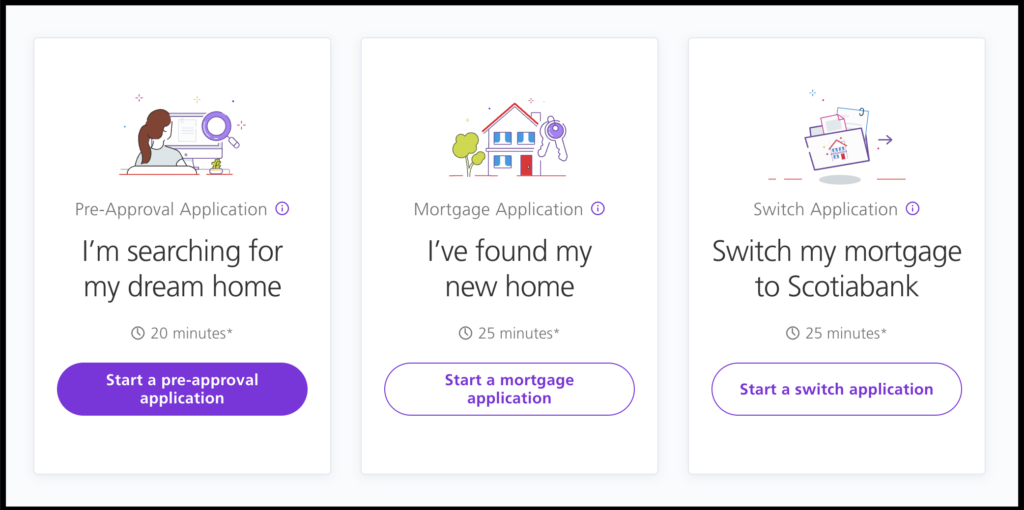
Once you’ve chosen the pre-approval option from the eHOME menu, you’ll begin an application process the bank estimates should take around 20 minutes.
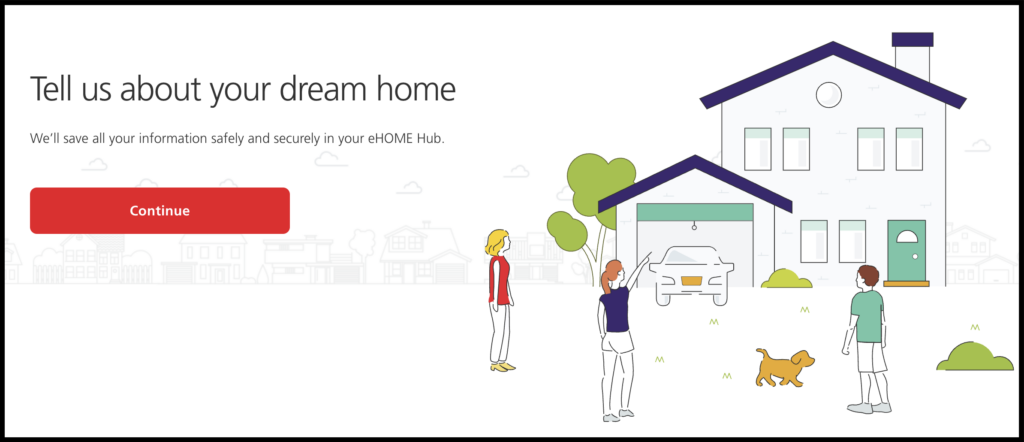
1. Provide details about the home you intend to buy, including:
- Its location.
- Whether it will be your primary residence or a secondary property.
- If it’s a house or condo.
- The estimated price.
- How much you’ve saved for a down payment.
- Your down payment sources.
It’s alright if you don’t know all every detail at this stage.

2. Choose a rate type and term length so Scotiabank can provide a few customized rate offers.
Choose the offer that looks good to you and you’ll have the option to lock it in for 120 days.
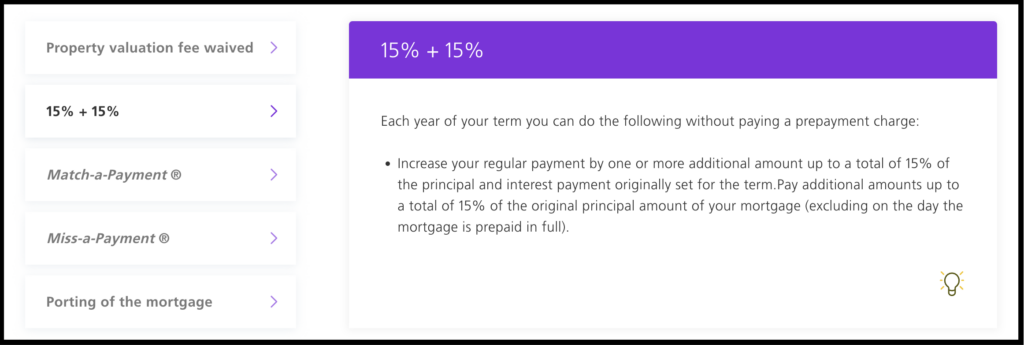
3. Review the details of your mortgage offer, including: prepayment privileges, porting possibilities and other features that can help you better manage your home loan.
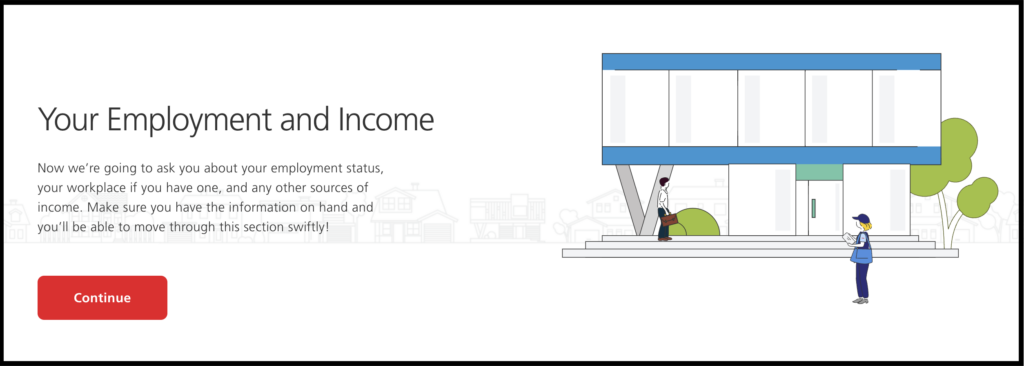
4. Provide your employment and income details, including:
- Your employment type and industry.
- Your employer’s name, phone number and address.
- Your annual income.
- How long you have worked there.
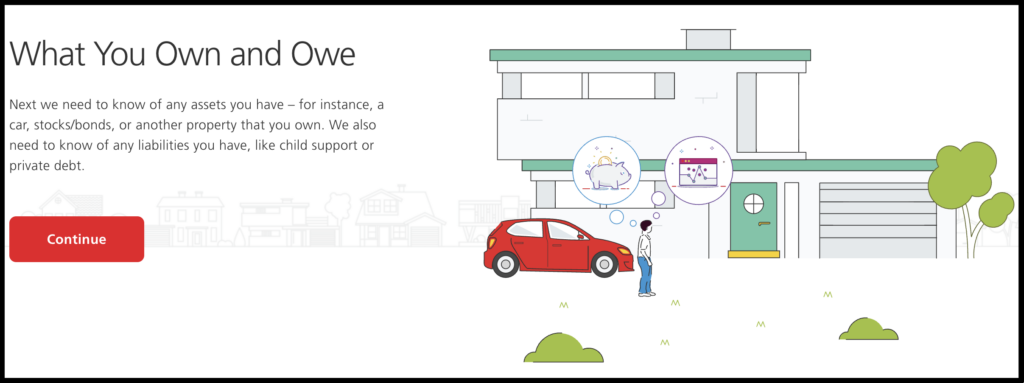
5. List your assets and debts, including:
- Your monthly rent or mortgage payments.
- How much each asset you own is worth and whether it’s held jointly.
- Whether you’re paying alimony, child support or private debt.
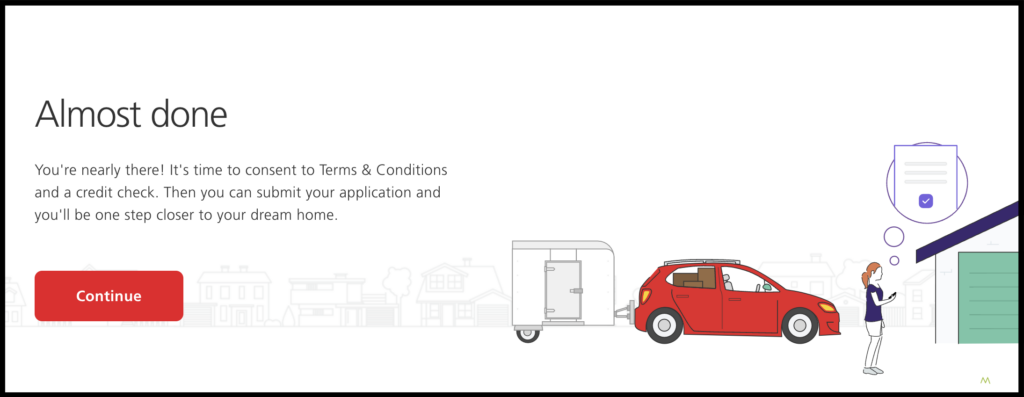
6. Read Scotiabank’s terms and conditions and consent to a credit check. The pre-approval process is complete!
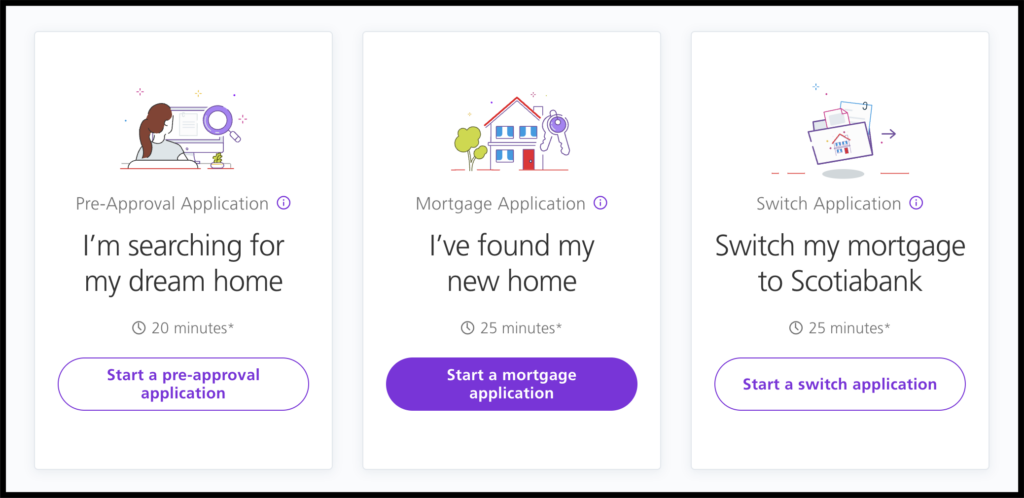
Once you reach the eHOME hub, chose the “Mortgage Application” option.
You’ll be asked to confirm your personal information and whether you’ll be applying with a co-applicant. Then you’ll begin the application process.

1. Provide details about the home you made an offer on, including:
- Its location.
- Whether it will be your primary residence or a secondary property.
- If it’s a house or condo, and whether it’s detached, semi-detached or a freehold townhouse.
- The square footage.
- The purchase price.
- Your down payment sources.
- The closing date.

2. Choose a rate type and term length so Scotiabank can provide a few customized rate offers.
Find an offer that looks good and you’ll have the option to lock it in for 90 days.

3. View the details of your mortgage offer, including prepayment privileges, porting possibilities and other features that can help you better manage your home loan.
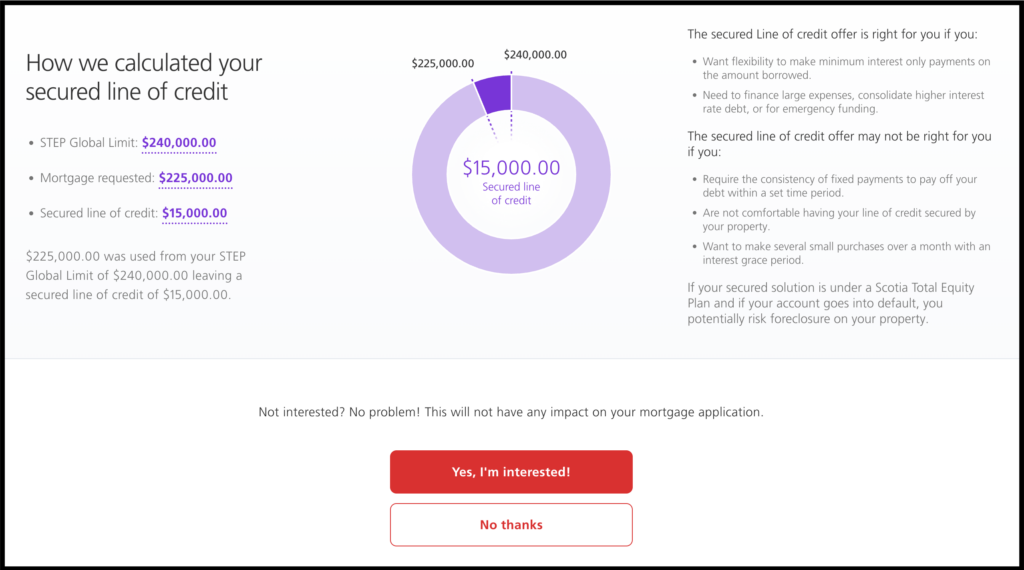
At this stage, you’ll be shown details regarding the Scotia Total Equity Plan, an optional home equity line of credit. You don’t have to sign up for STEP to continue with your application.

4. Provide your employment and income details, including:
- Your employment type and industry.
- Your employer’s name, phone number and address.
- Your annual income.
- How long you have worked there.
- If you have any other sources of income.
If you’ve previously completed a pre-approval application, these details should already be filled in.

5. Declare your assets and debts, including:
- Your monthly rent or mortgage payments.
- How much each asset you own is worth and whether it’s held jointly.
- If you’re paying alimony, child support or private debt.
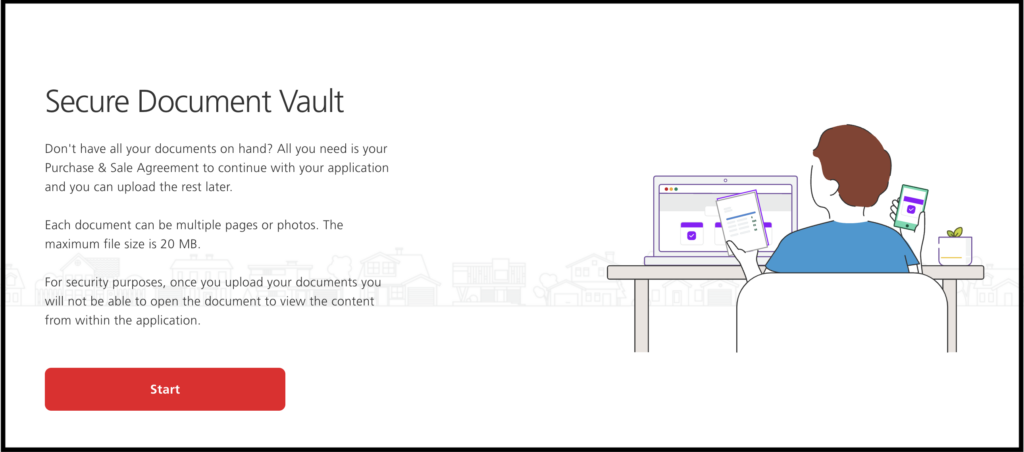
6. Upload the documents Scotiabank requires to verify your application details. At this point, you only need your purchase of sale agreement, but you’ll eventually need to provide:
- The house listing.
- Financial statements that confirm the ownership and value of the assets and investments you’ve declared.
- Employment and tax documents.
Providing all the documents requested will help speed along the approval process.

7. Read the terms and conditions related to your mortgage and consent to a credit check. Your mortgage application is complete!
Frequently asked questions about Scotiabank mortgage rates
Scotiabank’s prime rate is currently 4.95%.
You can — and should — negotiate your mortgage rate at Scotiabank. When you first apply for a mortgage, Scotiabank may not offer you the lowest rate possible. Ask for a lower one. Even if you’re only able to reduce the cost of your mortgage a little, the money saved can be put to a better use.
DIVE EVEN DEEPER

The Best Mortgage Rates in Canada
Quickly explore Canadian mortgage rates from bank and non-bank lenders. Find the best fixed or variable mortgage rate for your home buying needs.

Calculator: How Much Mortgage Can You Afford?
Use our mortgage affordability calculator to see how your interest rate, down payment and debt ratios affect your housing budget.

Canada Closing Costs Calculator
Create a more accurate home buying budget by estimating your closing costs — the one-time, upfront expenses you’ll pay before receiving the keys.

3 Ways to Take on a Budget-Busting Mortgage Renewal
With interest rates still high, renewing your mortgage probably won’t be the best part of your 2024. If you’re worried about the impending cost of your home loan, keep these strategies in mind.
